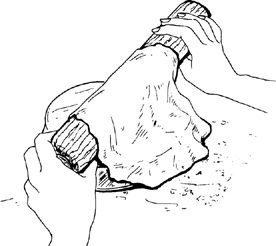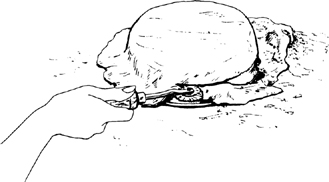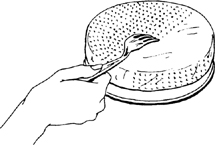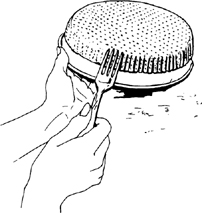Mastering the Art of French Cooking, Volume 2 (49 page)
Read Mastering the Art of French Cooking, Volume 2 Online
Authors: Julia Child

A more informal and simpler method is to bake the shell on an upside-down cake pan, or on any upside-down fireproof object whose shape appeals to you, such as a pie tin, bread pan, ring mold, saucepan, baking dish, or even muffin tin. For this type of shell you must have a pastry that is light and buttery but will hold its shape when molded and baked
upside down. The preceding egg pastry dough was designed especially for upside-down shells.
UPSIDE-DOWN PASTRY SHELLS
For a 10- by 1-inch round shell, or any shell formed on any 6- to 8-cup mold
1)
Forming shells
1 tsp soft butter
The mold: a round cake pan or baking dish 9 to 10 inches bottom diameter
½ the preceding egg pastry dough, chilled
Butter the outside of the mold and set upside down. Rapidly roll out the dough into a circle ⅛ inch thick and at least 2½ to 3 inches wider in diameter than
your mold. (Illustrated directions for rolling dough are on pages 141–4 in Volume I.)
| Roll dough up on pin and unroll over upturned bottom of mold |
Even off the edges around the sides of the mold with a ravioli wheel or knife, making shell about 1 inch deep. |
|
| To prevent shell from puffing out of shape during baking, prick all over at ⅛-inch intervals with a table fork. |
To even the sides all around press flat of fork against pastry, being careful not to reduce thickness |
|
So that dough will bake properly and not draw up or out of shape, it should now be refrigerated for at least an hour before it goes into the oven; this relaxes the gluten in the flour. Press raw leftover dough into a ball, wrap and refrigerate; you may need a little later on, after baking.
(*) Shell may be frozen at this point. Set as is in freezer for an hour or so until hardened, then wrap airtight. Bake shell while still frozen.
2)
Baking shells—after a rest of 1 hour
Preheat oven to 425 degrees. You will need to weight down the top of the dough after it has baked for 4 to 5 minutes, otherwise the top will puff and draw the sides up: choose a saucepan or baking dish weighing about 2 pounds, or a pie plate filled with dried beans, and butter the bottom of the pan, dish, or plate.
Place chilled dough-covered mold, still upside down, on a baking sheet and set in middle level of oven. In 4 to 5 minutes, place the buttered weight on top, remove 2 to 3 minutes before shell is done.
A partially baked shell, the type used for
quiches
and oven-baked tarts and pies, needs 6 to 10 minutes in all depending on the thickness of the dough. It is sufficiently baked when it has started to color and can be raised gently from the mold. Fully baked shells usually need 10 to 15 minutes in all, until the shell is nicely browned and crisp. When done, remove from oven and let cool on mold for 8 to 10 minutes, then, being very careful not to crack shell, unmold on a rack.






